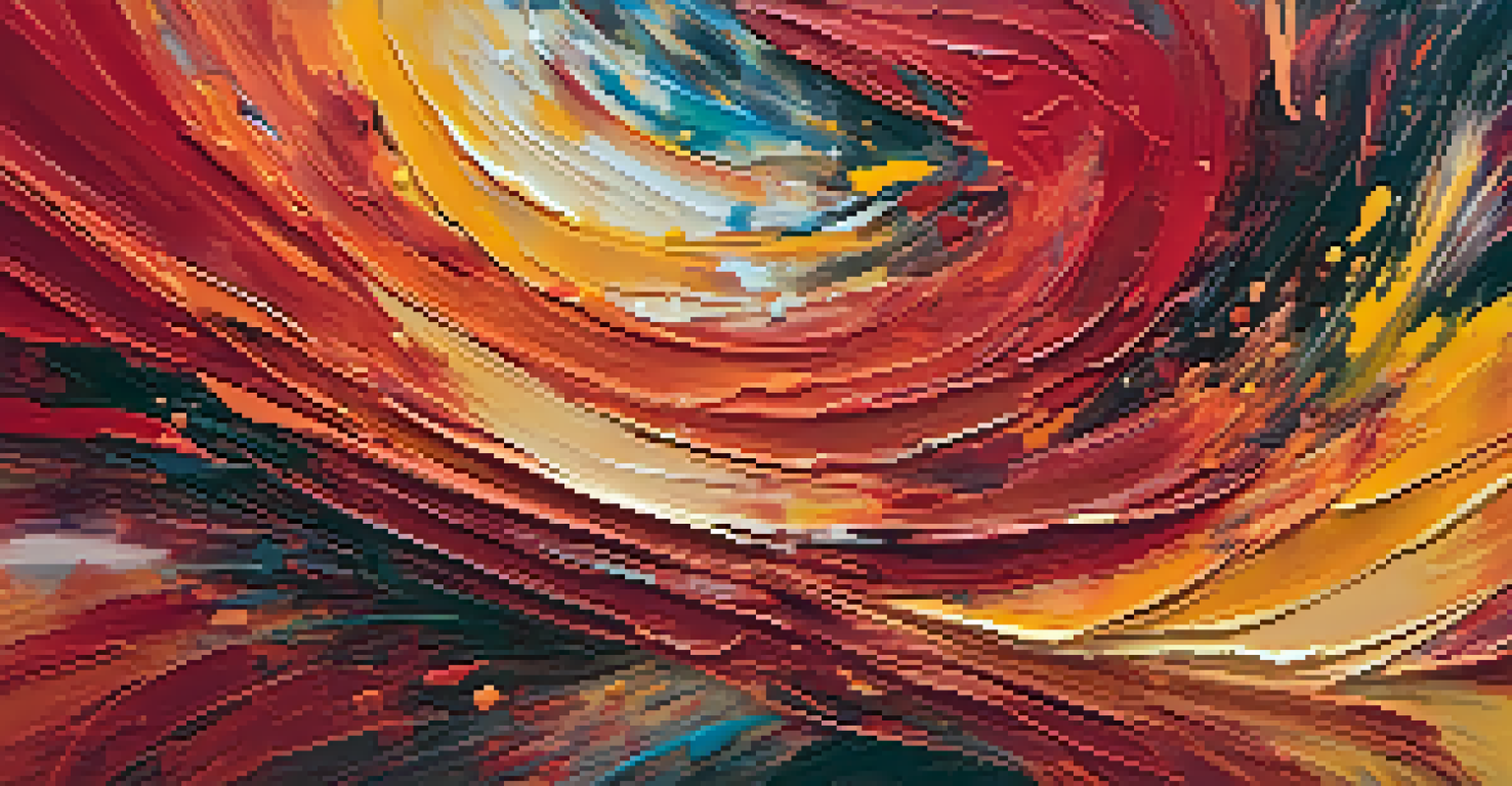The Psychology of Brush Strokes: Emotions in Every Stroke

Understanding the Connection Between Art and Emotion
Art has an incredible ability to evoke emotions, and brush strokes play a crucial role in this process. Each stroke carries a weight of intention and feeling, much like words in a poem. For instance, a gentle, sweeping stroke might indicate calmness, while jagged, aggressive strokes can convey turmoil or chaos.
Every artist dips his brush in his own soul, and paints his own nature into his pictures.
This connection is rooted in psychology; our brains instinctively respond to visual stimuli. When we look at a piece of artwork, we often feel a rush of emotions triggered by how the strokes interact with one another. This interplay helps create a narrative that resonates with the viewer's own experiences.
In essence, brush strokes are more than mere techniques; they are a language of emotion that speaks directly to our subconscious. By understanding this connection, artists can harness their brushwork to communicate their inner thoughts and feelings more effectively.
The Impact of Color on Brush Stroke Emotions
Color is a powerful component of art that significantly enhances the emotional weight of brush strokes. For example, warm colors like red and orange can evoke feelings of passion or anger, while cool colors such as blue and green often elicit calmness and tranquility. When combined with specific brush techniques, these colors can heighten the emotional impact.

Think about a landscape painting that uses vibrant, chaotic brush strokes in fiery reds and yellows; it may evoke a sense of urgency and excitement. On the other hand, a serene seascape painted with soft blues and gentle strokes can bring about feelings of peace and relaxation.
Art Evokes Emotion Through Technique
Brush strokes serve as a language of emotion, allowing artists to convey their inner thoughts and feelings effectively.
By consciously choosing colors and strokes, artists can create layered emotional experiences. This synergy between color and technique invites viewers to delve deeper into the emotions portrayed on the canvas.
Brush Stroke Techniques and Their Emotional Messages
Different brush stroke techniques convey distinct emotional messages to the viewer. For instance, a dry brush technique can create a sense of urgency or rawness, while smooth, blended strokes often promote feelings of calm and harmony. Each method tells its own story, contributing to the artwork's overall mood.
Color is the keyboard, the eyes are the harmonies, the soul is the piano with many strings.
Consider the difference between thick, impasto strokes that add texture and depth, suggesting intensity, versus delicate, feather-like strokes that evoke gentleness. This contrast illustrates how a simple change in technique can shift the emotional tone of an entire piece.
Ultimately, artists can use these techniques intentionally to guide the audience's emotional journey, adding layers of meaning and resonance to their work.
Cultural Influences on Brush Stroke Interpretations
Cultural backgrounds heavily influence how brush strokes are perceived and interpreted. Different cultures have unique artistic traditions that shape their emotional expressions. For example, traditional Japanese ink wash painting emphasizes simplicity and subtlety, often reflecting a deep appreciation for nature and tranquility.
In contrast, Western abstract art may prioritize bold colors and aggressive strokes, portraying the artist's inner turmoil or societal issues. These cultural contexts inform how viewers respond emotionally to the strokes used, creating a diverse landscape of interpretation.
Color Enhances Emotional Impact
The choice of colors in art significantly influences the emotional weight of brush strokes, creating layered experiences for viewers.
Understanding these influences is crucial for both artists and viewers. It enriches the dialogue around art, allowing for a deeper appreciation of the emotional narratives conveyed through brush work.
The Role of Artist Intent in Emotional Expression
Artist intent plays a pivotal role in the emotional expression of brush strokes. When creating art, an artist often channels their emotions, experiences, and thoughts through their brushwork. This genuine expression can resonate powerfully with viewers, allowing them to feel and connect with the artwork on a deeper level.
For instance, an artist might be processing grief and convey this through dark, heavy strokes that reflect their emotional weight. Conversely, joyous moments might be captured with bright, playful strokes that dance across the canvas.
This connection between artist intent and brush strokes invites a personal dialogue between the creator and the observer, making the emotional experience of art all the more profound.
The Viewer’s Emotional Response to Brush Strokes
The viewer's emotional response is an integral part of the art experience, influenced heavily by brush strokes. Each individual brings their own life experiences and emotions to the artwork, which can alter their interpretation of the strokes. For example, a viewer who has experienced loss may resonate more deeply with darker, heavier strokes in a painting.
This unique interaction creates a dynamic relationship between the artwork and its audience. The same piece can provoke a range of emotions in different viewers, highlighting the subjectivity of art.
Cultural Context Shapes Interpretations
Cultural backgrounds play a crucial role in how brush strokes are perceived, enriching the emotional narratives within artwork.
Ultimately, the emotional journey facilitated by brush strokes enriches the overall experience of art, making it a deeply personal exploration for each observer.
The Future of Brush Strokes and Emotional Expression in Art
As art continues to evolve, so too does the role of brush strokes in conveying emotion. With advancements in technology and new mediums, artists are experimenting with unconventional techniques and materials. This exploration opens up fresh avenues for emotional expression and connection with viewers.
For instance, digital artists can manipulate brush strokes in ways traditional mediums may not allow, creating immersive emotional experiences that challenge our perceptions. This innovation invites a new generation of artists to express complex emotions through their work.

As we look to the future, it's exciting to consider how these evolving techniques will further deepen our understanding of the emotional language of brush strokes, fostering even richer connections between art and its audience.